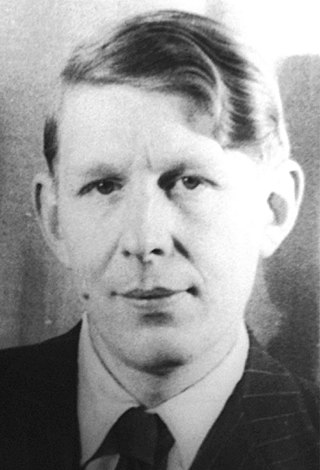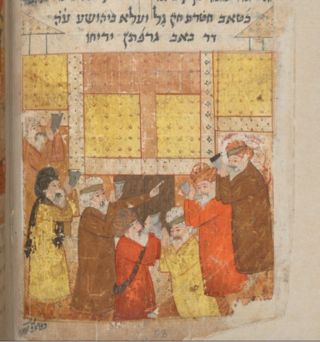
Herman Melville was an American novelist, short story writer, and poet of the American Renaissance period. Among his best-known works are Moby-Dick (1851); Typee (1846), a romanticized account of his experiences in Polynesia; and Billy Budd, Sailor, a posthumously published novella. At the time of his death, Melville was no longer well known to the public, but the 1919 centennial of his birth was the starting point of a Melville revival. Moby-Dick eventually would be considered one of the great American novels.

Wystan Hugh Auden was a British-American poet. Auden's poetry is noted for its stylistic and technical achievement, its engagement with politics, morals, love, and religion, and its variety in tone, form, and content. Some of his best known poems are about love, such as "Funeral Blues"; on political and social themes, such as "September 1, 1939" and "The Shield of Achilles"; on cultural and psychological themes, such as The Age of Anxiety; and on religious themes, such as "For the Time Being" and "Horae Canonicae".

Marie de France was a poet, possibly born in what is now France, who lived in England during the late 12th century. She lived and wrote at an unknown court, but she and her work were almost certainly known at the royal court of King Henry II of England. Virtually nothing is known of her life; both her given name and its geographical specification come from manuscripts containing her works. However, one written description of her work and popularity from her own era still exists. She is considered by scholars to be the first woman known to write francophone verse.

Callimachus was an ancient Greek poet, scholar and librarian who was active in Alexandria during the 3rd century BC. A representative of Ancient Greek literature of the Hellenistic period, he wrote over 800 literary works, most of which do not survive, in a wide variety of genres. He espoused an aesthetic philosophy, known as Callimacheanism, which exerted a strong influence on the poets of the Roman Empire and, through them, on all subsequent Western literature.

Blickling Hall is a Jacobean stately home situated in 5,000 acres of parkland in a loop of the River Bure, near the village of Blickling north of Aylsham in Norfolk, England. The mansion was built on the ruins of a Tudor building for Sir Henry Hobart from 1616 and designed by Robert Lyminge. The library at Blickling Hall contains one of the most historically significant collections of manuscripts and books in England, containing an estimated 13,000 to 14,000 volumes. The core collection was formed by Sir Richard Ellys. The property passed into the care of the National Trust in 1940.

Judeo-Persian refers to both a group of Jewish dialects spoken by the Jews living in Iran and Judeo-Persian texts. As a collective term, Judeo-Persian refers to a number of Judeo-Iranian languages spoken by Jewish communities throughout the formerly extensive Persian Empire, including the Mountain and Bukharan Jewish communities.
Arabic literature is the writing, both as prose and poetry, produced by writers in the Arabic language. The Arabic word used for literature is Adab, which comes from a meaning of etiquette, and which implies politeness, culture and enrichment.

The maqāma is an (originally) Arabic prosimetric literary genre of picaresque short stories originating in the tenth century C.E. The maqāmāt are anecdotes told by a fictitious narrator which typically follow the escapades of a roguish protagonist as the two repeatedly encounter each other in their travels. The genre is known for its literary and rhetorical complexity, as well as its alternating use of rhymed verse with a form of Arabic rhymed prose known as saj’. The two most well-known authors within the genre are Badī' al-Zaman al-Hamadhāni, one of its earliest exponents, and al-Harīrī of Basra, whose maqāmāt are commonly held responsible for the genre's rise in popularity from the eleventh century onward. Interest in al-Hariri's Maqāmāt spread throughout much of the Islamic Empire, with translations and original works appearing in Hebrew, Syriac and Persian. Many authors still contribute to and draw inspiration from the literary genre of Maqāma to this day.

The Georgics is a poem by Latin poet Virgil, likely published in 29 BCE. As the name suggests the subject of the poem is agriculture; but far from being an example of peaceful rural poetry, it is a work characterized by tensions in both theme and purpose.

Restoration literature is the English literature written during the historical period commonly referred to as the English Restoration (1660–1688), which corresponds to the last years of Stuart reign in England, Scotland, Wales, and Ireland. In general, the term is used to denote roughly homogenous styles of literature that centre on a celebration of or reaction to the restored court of Charles II. It is a literature that includes extremes, for it encompasses both Paradise Lost and the Earl of Rochester's Sodom, the high-spirited sexual comedy of The Country Wife and the moral wisdom of The Pilgrim's Progress. It saw Locke's Treatises of Government, the founding of the Royal Society, the experiments and holy meditations of Robert Boyle, the hysterical attacks on theatres from Jeremy Collier, and the pioneering of literary criticism from John Dryden and John Dennis. The period witnessed news becoming a commodity, the essay developing into a periodical art form, and the beginnings of textual criticism.

The Book of Good Love, considered to be one of the masterpieces of Spanish poetry, is a pseudo-biographical account of romantic adventures by Juan Ruiz, the Archpriest of Hita, the earliest version of which dates from 1330; the author completed it with revisions and expansions in 1343.

Erec and Enide is the first of Chrétien de Troyes' five romance poems, completed around 1170. It is one of three completed works by the author. Erec and Enide tells the story of the marriage of the titular characters, as well as the journey they go on to restore Erec's reputation as a knight after he remains inactive for too long. Consisting of about 7000 lines of Old French, the poem is one of the earliest known Arthurian romances in any language, predated only by the Welsh prose narrative Culhwch and Olwen.
An overview of the history of theatre of France.

Ampton is a village and civil parish in the West Suffolk District of Suffolk, England, about five miles north of Bury St Edmunds.

This glossary of literary terms is a list of definitions of terms and concepts used in the discussion, classification, analysis, and criticism of all types of literature, such as poetry, novels, and picture books, as well as of grammar, syntax, and language techniques. For a more complete glossary of terms relating to poetry in particular, see Glossary of poetry terms.

Sir Clement Higham MP JP PC of Barrow, Suffolk, was an English lawyer and politician, a Speaker of the House of Commons in 1554, and Chief Baron of the Exchequer in 1558–1559. A loyal Roman Catholic, he held various offices and commissions under Queen Mary, and was knighted in 1555 by King Philip, but withdrew from politics after the succession of Queen Elizabeth I in 1558.
The long poem is a literary genre including all poetry of considerable length. Though the definition of a long poem is vague and broad, the genre includes some of the most important poetry ever written.

A novel is an extended work of narrative fiction usually written in prose and published as a book. The English word to describe such a work derives from the Italian: novella for "new", "news", or "short story ", itself from the Latin: novella, a singular noun use of the neuter plural of novellus, diminutive of novus, meaning "new". According to Margaret Doody, the novel has "a continuous and comprehensive history of about two thousand years", with its origins in the Ancient Greek and Roman novel, Medieval Chivalric romance, and in the tradition of the Italian Renaissance novella. The ancient romance form was revived by Romanticism, in the historical romances of Walter Scott and the Gothic novel. Some novelists, including Nathaniel Hawthorne, Herman Melville, Ann Radcliffe, and John Cowper Powys, preferred the term "romance". M. H. Abrams and Walter Scott have argued that a novel is a fiction narrative that displays a realistic depiction of the state of a society, while the romance encompasses any fictitious narrative that emphasizes marvellous or uncommon incidents. Works of fiction that include marvellous or uncommon incidents are also novels, including Mary Shelley's Frankenstein, J. R. R. Tolkien's The Lord of the Rings, and Harper Lee's To Kill a Mockingbird. Such "romances" should not be confused with the genre fiction romance novel, which focuses on romantic love.
Anthony Hammond (1668–1738), of Somersham Place, Somersham, Huntingdonshire and Lidlington, Bedfordshire, was an English official and Tory politician who sat in the English and British House of Commons between 1695 and 1708. He was also known as a poet and pamphleteer.
The Iskandarnameh is a poetic production in the Alexander Romance tradition authored by the Persian poet Nizami Ganjavi that describes Alexander the Great as an idealized hero, sage, and king. More uniquely, he is also a seeker of knowledge who debates with great philosophers Greek and Indian philosophers, one of them being Plato.


















